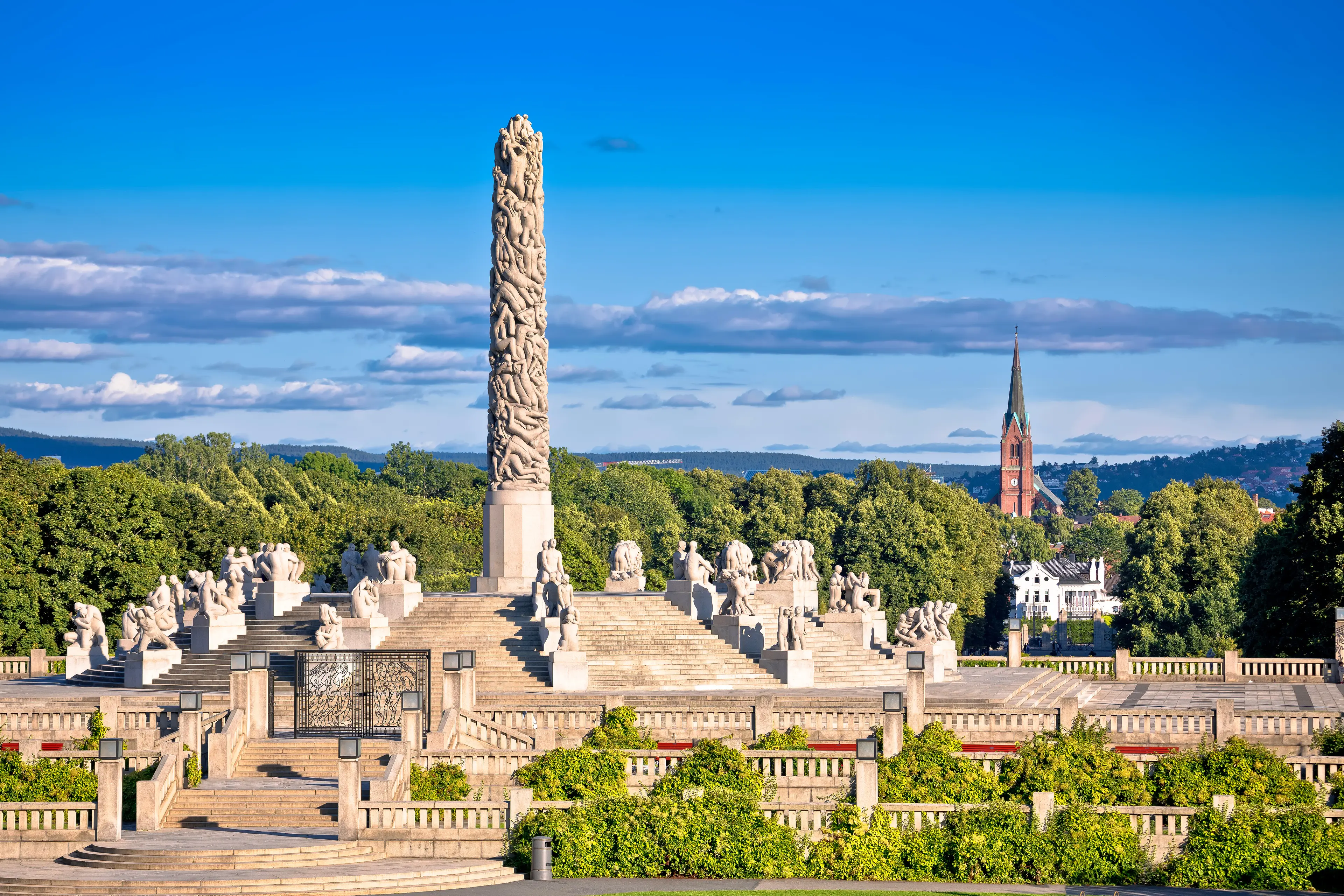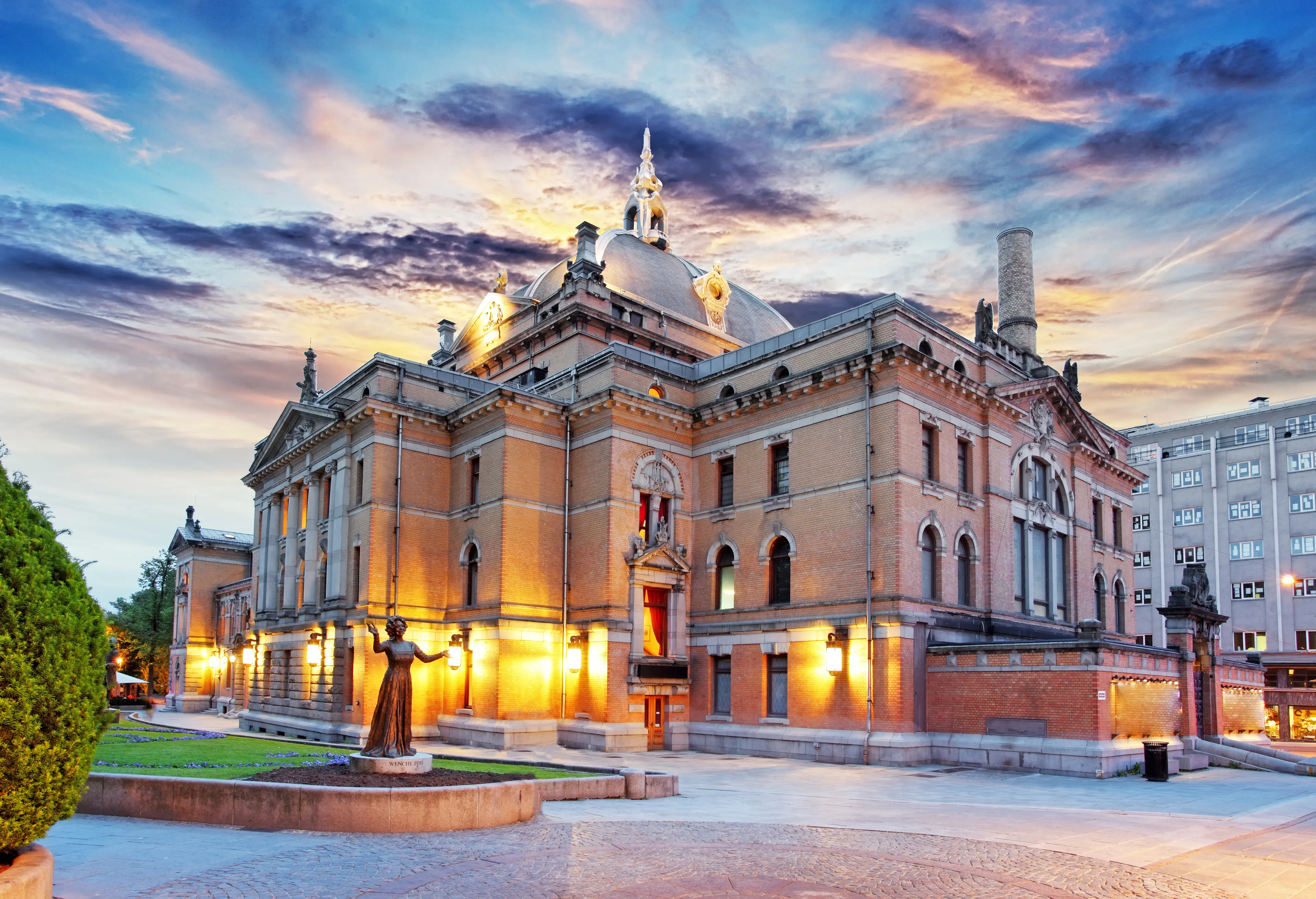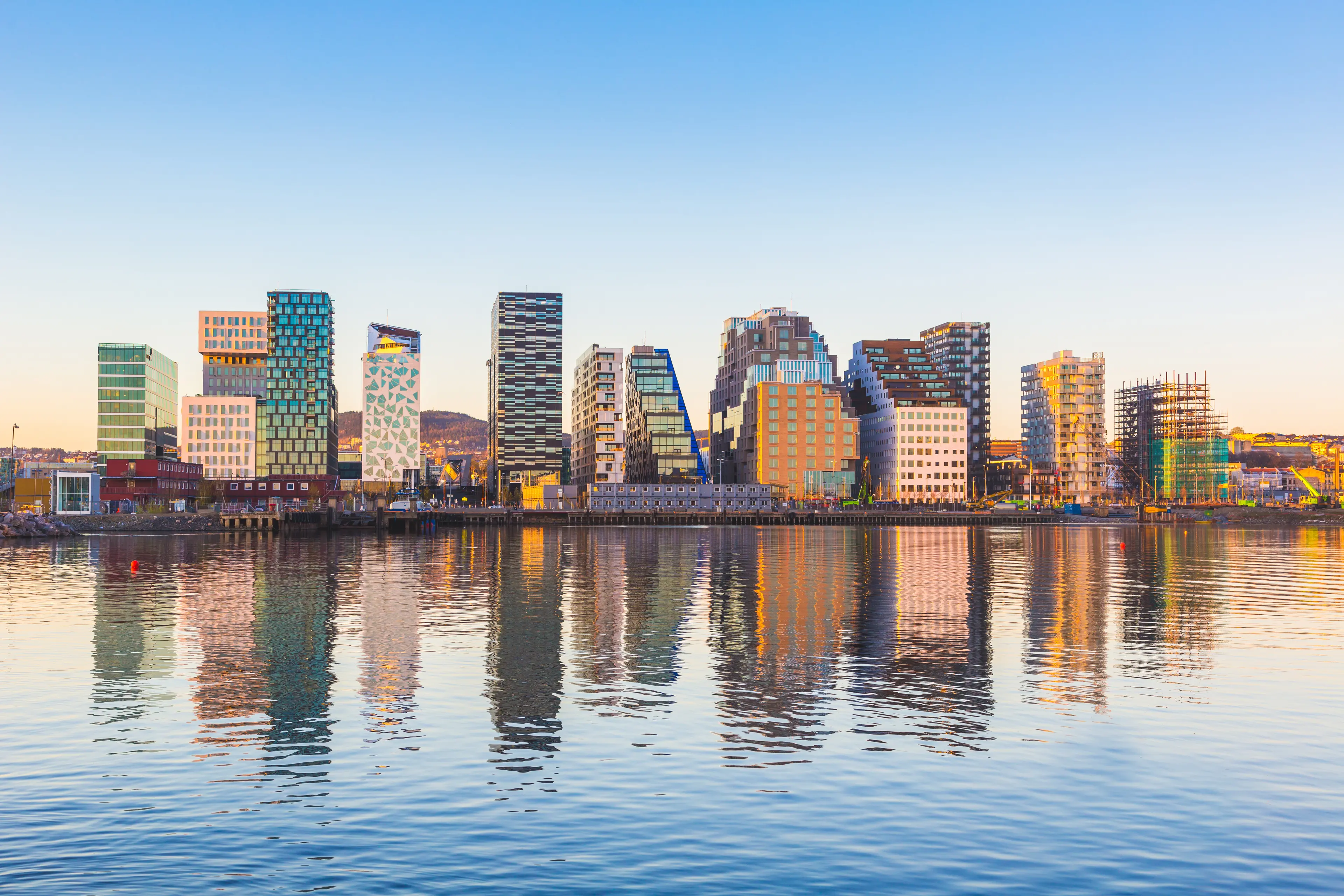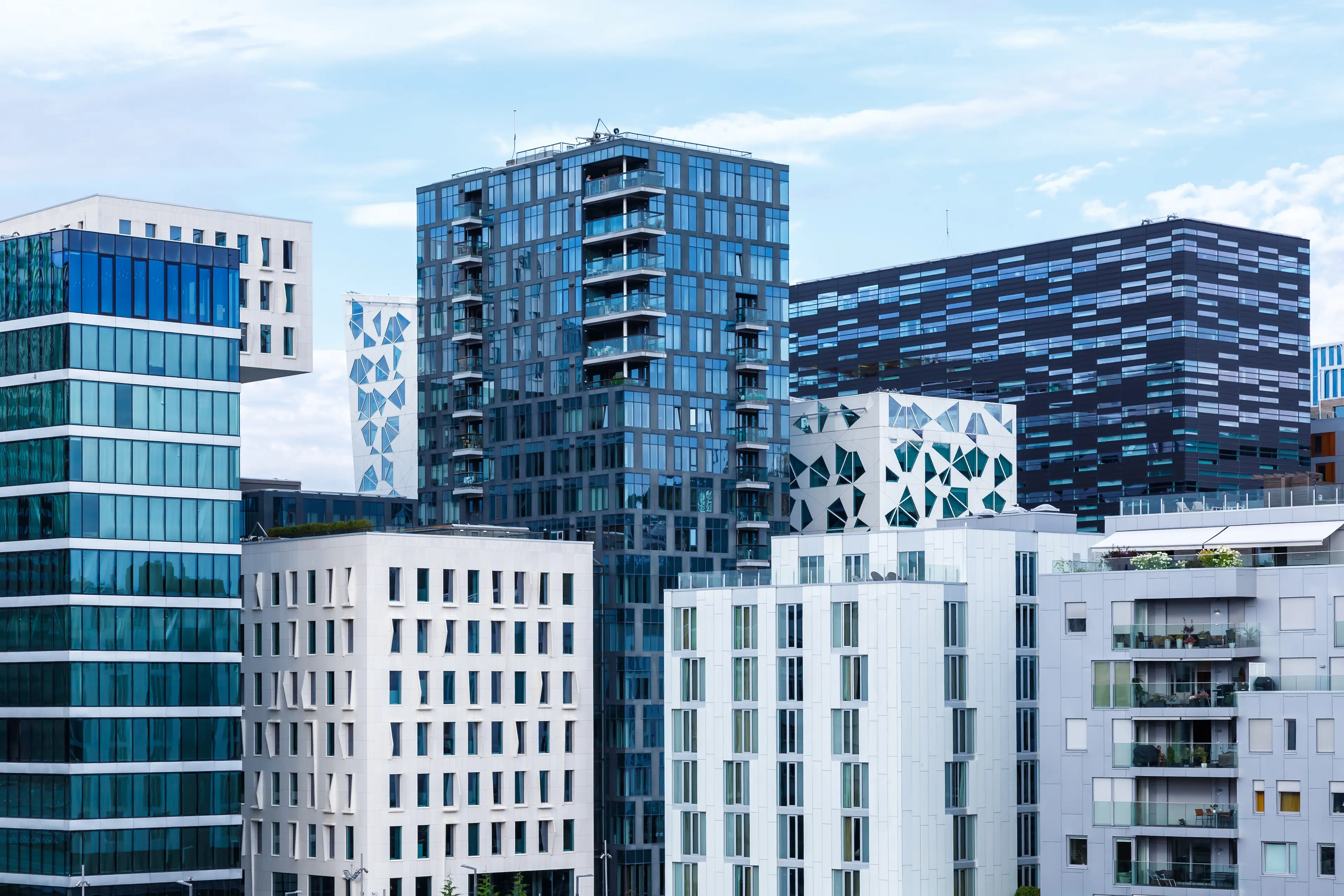1-Day Solo Local Experience: Oslo's Sights, Tastes & Wines
Oslo, Norway
1 days





About Oslo, Norway
Oslo, the capital of Norway, is a perfect blend of natural beauty and urban life. Known for its sea-facing landscapes, lush green parks, and modern architecture, Oslo offers a unique cultural experience with its world-class museums, including the Viking Ship Museum and the Munch Museum. The city's rich history is evident in the medieval Akershus Fortress. Oslo also boasts a vibrant nightlife with numerous restaurants serving traditional Norwegian cuisine. Outdoor enthusiasts can enjoy activities like hiking, cycling, and skiing. Don't miss the breathtaking view of the city from the Holmenkollen Ski Jump. Oslo is also a gateway to explore the stunning fjords of Norway.
1-Day Itinerary
Attractions in Itinerary (6)

1Oslo Opera House
A stunning piece of modern architecture, the Oslo Opera House is home to The Norwegian National Opera and Ballet, and the national opera theatre in Norway.

2Barcode district
The Barcode District is a section of Oslo that has been recently redeveloped. It's known for its distinctive skyline, which is broken up by tall, narrow buildings of different heights and widths, resembling a barcode when viewed from certain angles. It's a bustling area with a mix of residential spaces, offices, and cultural institutions, as well as plenty of restaurants and cafes.

3Viking Ship Museum
Home to three Viking era burial ships that are the best-preserved in the world.

4Frogner Park
Home to the world-famous Vigeland Sculpture Park, Frogner Park is the largest park in Oslo and a popular recreational area.

5Vigeland Sculpture Park
Vigeland Park is the world's largest sculpture park made by a single artist, and is one of Norway's most popular tourist attractions. The park is open to visitors all year round.

6Akershus Fortress
A medieval castle that was built to protect Oslo, it has also been used as a prison.
Local Food and Drinks (12)

Fårikål
Fårikål is Norway's national dish, made from mutton with bone, cabbage, whole black pepper, and often a little wheat flour. It's traditionally served with potatoes boiled in their jackets.

Rakfisk
Rakfisk is a traditional Norwegian dish made from fermented fish, typically trout. It has a strong smell and taste and is often served with flatbread and sour cream.

Klippfisk
Klippfisk is dried and salted cod, a staple in Norwegian cuisine. It's often served with accessories like bacon, cream sauce, and vegetables.

Lutefisk
Lutefisk is a traditional Norwegian dish made from dried white fish and lye. It's usually served with potatoes, green peas, and melted butter.

Pinnekjøtt
Pinnekjøtt is a traditional Norwegian Christmas dish typical to Western- and Northern Norway. It's made from rib of lamb or mutton salted and dried, and then steamed.

Kjøttkaker
Kjøttkaker are large, round meatballs, usually served with peas, potatoes, and gravy. It's a classic Norwegian comfort food.

Raspeballer
Raspeballer, also known as 'komle', is a potato dumpling, a traditional Norwegian dish. It's typically served with bacon, sausages or sheep meat.

Krumkake
Krumkake is a traditional Norwegian waffle cookie, made of flour, sugar, eggs, and butter. It's rolled into a cone shape and often filled with whipped cream or other fillings.

Multekrem
Multekrem is a traditional Norwegian dessert, made with cloudberries, sugar, and whipped cream. It's often served during Christmas.

Aquavit
Aquavit is a traditional Norwegian spirit distilled from potatoes and grains, flavored with herbs. It's often served during festive gatherings such as Christmas and weddings.

Gløgg
Gløgg is a traditional Norwegian Christmas drink, a type of mulled wine made with red wine, spices, and nuts. It's often served with raisins and almonds.

Mjød
Mjød is a traditional Norwegian honey wine, similar to mead. It's often served during Viking-themed events or medieval festivals.
Best time to visit
The best time to visit Oslo, Norway is during the summer months from June to August. During this period, the weather is warm and pleasant, with average temperatures ranging from 18°C to 25°C. This is also the time when the city has the longest days, allowing you to explore more in daylight. Moreover, many of Oslo's popular festivals, like the Oslo Jazz Festival, take place during the summer. However, if you're interested in winter sports like skiing, the months from November to April would be ideal for your visit.
How to get around
Oslo Metro
The Oslo Metro, locally known as T-bane, is a convenient way to get around the city. It has six lines that cover most of the city and some suburbs. The metro operates from early morning until late at night, with more frequent services during peak hours.
Bus
Buses in Oslo are extensive and reliable, covering areas not reached by the metro. The main bus terminal is located at Oslo Central Station. Buses run frequently during the day and less frequently at night.
Tram
The Oslo Tram network is another popular mode of transport. It has six lines that cover the city centre and some suburbs. Trams run from early morning until late at night, with more frequent services during peak hours.
Ferry
Ferries in Oslo provide a scenic way to travel. They connect the city centre with the islands in the Oslo Fjord and the peninsula of Bygdøy, where several museums are located.
Bicycle
Oslo is a bike-friendly city with many dedicated bike lanes and bike rental services. The city's bike sharing scheme, Oslo City Bike, has stations all over the city.
Car
Driving in Oslo can be challenging due to heavy traffic, tolls, and limited parking. However, car rental services are available for those who prefer this mode of transport.
Taxi
Taxis are readily available in Oslo, but they can be expensive. They can be hailed on the street, picked up at taxi ranks, or booked in advance.
Ridesharing
Ridesharing services like Uber are available in Oslo. This can be a convenient and sometimes cheaper alternative to traditional taxis.
Foot
Oslo's city centre is compact and pedestrian-friendly, making walking an enjoyable and practical way to get around. Many of the city's main attractions are within walking distance of each other.
Train
The Norwegian State Railways operates trains in and out of Oslo Central Station, connecting the city with other parts of Norway and some international destinations.
Important information
Currencykr NOK
Time zoneUTC+1
Driving sideRight
Emergency phone112, 110
Drinking waterYes
Power sockets
Voltage230 V
Things to know about Oslo, Norway as a first time visitor
1
Norwegian Krone (NOK) is the official currency of Norway. It's advisable to have some local currency for small expenses.
2
Norway is a cashless society. Most places, including taxis, prefer card payment. Make sure your card is enabled for international transactions.
3
The official language is Norwegian, but English is widely spoken and understood.
4
Norway is known for its high cost of living. Expect to pay more for food, drinks, and services compared to other European countries.
5
Tipping is not mandatory but appreciated. A tip of 10-15% is common for good service in restaurants.
6
Public transportation in Oslo is efficient and reliable. It includes buses, trams, ferries, and the metro.
7
The Oslo Pass gives you free entry to more than 30 museums and attractions, free travel on all public transport, and special offers in restaurants, shops, entertainment, and leisure venues.
8
Norway uses the European two-pin plug (Type C & F, 230V, 50Hz). Make sure to bring an adapter if your devices use a different type of plug.
9
The emergency number in Norway is 112 for police, 113 for medical, and 110 for fire.
10
Norway has a zero-tolerance policy for drinking and driving. The legal limit is very low (0.02% BAC), so it's best not to drink at all if you plan on driving.
11
Oslo is generally safe, but like any city, it's advisable to stay vigilant, especially at night and in less crowded areas.
12
Norway has a right to roam law, which allows you to freely camp, hike, and pick berries and mushrooms in uncultivated land.
13
The weather in Oslo can be unpredictable. It's advisable to pack layers and waterproof clothing. In winter, temperatures can drop to -4°F to 23°F (-20°C to -5°C), and in summer, they can range from 48°F to 70°F (9°C to 21°C).
14
Norway is one hour ahead of Coordinated Universal Time (UTC+1). During daylight saving time (last Sunday in March to last Sunday in October), it's UTC+2.
15
Norway has strict laws for buying alcohol. Beer can be bought in supermarkets until 8 pm on weekdays and 6 pm on Saturdays. For wine and spirits, you need to visit a Vinmonopolet store, which has limited opening hours.
16
Smoking is banned in all public indoor spaces and public transportation. This includes bars and restaurants.
17
Tap water in Oslo is of high quality and perfectly safe to drink.
18
Norwegians value punctuality. It's considered rude to be late for appointments or social engagements.
19
Norway has a comprehensive recycling system. Make sure to sort your waste according to local guidelines.
20
If you're planning to do some shopping, keep in mind that most stores close early on Saturdays and are closed on Sundays.
Basic Norwegian to know as a first time visitor
English phrase | Native phrase | Pronunciation | When to use it |
|---|---|---|---|
Hello | Hei | hay | Greeting someone |
Goodbye | Ha det | ha de | Leaving or saying goodbye |
Please | Vær så snill | ver so snil | Making a request |
Thank you | Takk | tak | Expressing gratitude |
You're welcome | Vær så god | ver so good | Responding to thank you |
Excuse me | Unnskyld meg | un-shild me | Getting attention or apologizing |
Yes | Ja | ya | Agreeing or affirming |
No | Nei | nay | Disagreeing or denying |
I don't understand | Jeg forstår ikke | yay for-stor ik-ke | Confusion or misunderstanding |
Do you speak English? | Snakker du engelsk? | snak-ker doo eng-elsk | Asking for language assistance |
Where is the bathroom? | Hvor er toalettet? | vor er toa-let-et | Looking for the bathroom |
How much does this cost? | Hvor mye koster dette? | vor mye kos-ter det-te | Asking for the price |
I'm lost | Jeg er tapt | yay er tapt | Asking for directions |
Can you help me? | Kan du hjelpe meg? | kan doo yel-pe me | Asking for help |
I'm sorry | Jeg beklager | yay be-klag-er | Apologizing |
Good morning | God morgen | god morgen | Morning greeting |
Good night | God natt | god nat | Night time farewell |
I would like... | Jeg vil gjerne ha... | yay vil yer-ne ha | Making a request |
Where is... | Hvor er... | vor er | Asking for directions |
Can I have the menu, please? | Kan jeg få menyen, vær så snill? | kan yay fo men-yen, ver so snil | At a restaurant |
Packing List
Clothing
Comfortable walking shoes
Lightweight jacket
Sweater or sweatshirt
T-shirts
Jeans or comfortable pants
Underwear
Socks
Scarf, gloves, and hat (if in winter)
Rain jacket or umbrella
Toiletries
Travel-sized toothpaste
Toothbrush
Deodorant
Razor
Shampoo and conditioner
Body wash or soap
Hand sanitizer
Travel-sized first aid kit
Prescription medications
Sunscreen
Travel documents and essentials
Passport
Driver's license or ID card
Credit and debit cards
Cash in local currency (Norwegian krone)
Travel insurance documents
Hotel and transportation reservations
Emergency contacts and addresses
Electronics and gadgets
Smartphone
Charger for smartphone
Headphones
Camera
Charger for camera
Universal power adapter
Portable power bank
Miscellaneous items
Snacks
Water bottle
Travel guidebook for Oslo
Map of Oslo
Travel pillow
Earplugs and eye mask
Reusable shopping bag
Notebook and pen
Weather Conditions
Oslo, the capital of Norway, experiences a humid continental climate, which means you can expect significant temperature differences between seasons. During the winter months, from December to February, Oslo can be quite cold, with temperatures often dropping below freezing. Average temperatures range from -7°C to -1°C (19°F to 30°F). Snow is common, so if you're planning a winter visit, pack warm clothing, including a heavy coat, gloves, scarves, and snow boots. This is also a great time for winter sports enthusiasts to visit, as skiing and snowboarding conditions are excellent. Spring, from March to May, sees a gradual warming with temperatures ranging from 0°C to 13°C (32°F to 55°F). This is a beautiful time to visit as the city begins to thaw and the days get longer. Pack layers as the weather can still be unpredictable. Summer, from June to August, is the warmest time of the year in Oslo. Temperatures can reach up to 22°C (72°F), but can drop to around 10°C (50°F) at night. This is the best time to explore the city's parks and outdoor attractions. Light clothing is recommended, but it's always a good idea to bring a light jacket or sweater for the cooler evenings. Autumn, from September to November, sees temperatures drop from 16°C to 3°C (61°F to 37°F). The city is beautiful during this time as the leaves change color, but be prepared for rain and pack waterproof clothing. Regardless of when you visit, it's always a good idea to check the weather forecast before your trip to ensure you're packing appropriately. Also, keep in mind that Oslo is quite far north, so daylight hours vary significantly throughout the year - from just a few hours in winter to almost 24 hours in summer. Plan your activities accordingly.
| Month | Hi / Lo (°C) | Weather Overview |
|---|---|---|
January | 2° / -6° | January is the coldest month in Oslo, with frequent snowfall and short daylight hours. Dress warmly and enjoy winter activities like skiing. |
February | 3° / -6° | February is still very cold with a high chance of snow. It's a great time to visit for winter sports enthusiasts. |
March | 7° / -3° | March sees the beginning of spring with slightly warmer temperatures. However, there's still a chance of snow, so pack accordingly. |
April | 13° / 1° | April is a transitional month with longer daylight hours and the last of the winter chill. It's a good time to explore the city and its parks. |
May | 18° / 6° | May brings warmer temperatures and the blooming of flowers. It's a great time to visit the fjords and enjoy outdoor activities. |
June | 22° / 10° | June is the start of summer with long days due to the midnight sun. This is the perfect time for sightseeing and hiking. |
July | 24° / 12° | July is the warmest month in Oslo with plenty of sunshine. Enjoy the city's outdoor cafes, parks, and the beach. |
August | 22° / 12° | August is still warm with long daylight hours. It's a great time for outdoor concerts and festivals. |
September | 18° / 8° | September marks the beginning of autumn with cooler temperatures and changing foliage. It's a good time for hiking and enjoying the fall colors. |
October | 12° / 4° | October is a cool month with shorter days and a higher chance of rain. Pack warm clothes and enjoy the indoor attractions. |
November | 7° / -1° | November is a cold month with the first snowfall of the season. It's a good time to visit museums and indoor attractions. |
December | 4° / -4° | December is a festive month with Christmas markets and snow. Enjoy the holiday spirit and winter activities. |
Did you know?
Places near by Oslo, Norway

Drobak
A charming small town known for its Christmas House and Santa's post office.

Fredrikstad
A city with a beautifully preserved Old Town (Gamlebyen) that's encircled by a 16th-century star fort.

Drøbak Aquarium
Norway's only year-round open saltwater aquarium with more than 100 species.

TusenFryd Amusement Park
Norway's largest amusement park offering fun for the whole family.

Hadeland Glassworks
One of the oldest industrial companies in Norway known for its beautiful glass products.

Kongsberg Silver Mines
A historical silver mining site offering guided tours underground.

Sandefjord
A popular holiday destination known for its Viking history and whaling museum.

Lillehammer
A city known for hosting the 1994 Winter Olympics, with a large open-air museum and ski jump hill.

Horten
A city known for its naval history, with a large maritime museum and several historical ships.

Drammen
A city known for its cultural life and river, with several museums and a large water park.